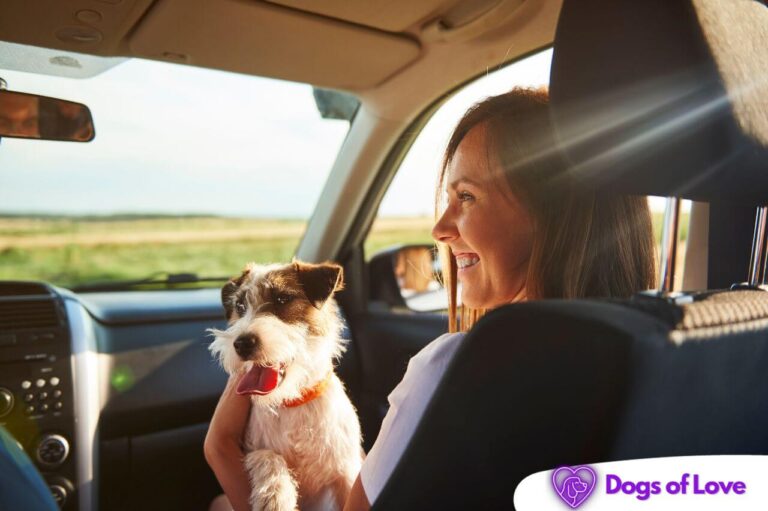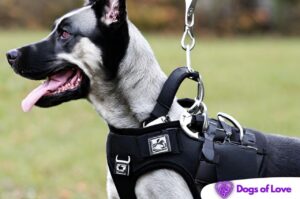Many pet owners consider their dogs beloved family members, and ensuring their safety during car rides is a top priority.
With this in mind, dog seat belts have gained popularity as a potential solution to keep our furry companions secure while traveling in vehicles.
But how effective are these pet restraints in practice? Are they reliable means of safeguarding our dogs and reducing the risks associated with car travel?
In this exploration, we will delve into the world of dog seat belts to examine their efficacy, benefits, and potential drawbacks. We aim to provide a clearer understanding of whether these safety devices genuinely live up to their claims.

What are dog seat belts, and why they’re essential?
Dog seat belts, called canine car restraints, are specialized devices designed to secure dogs in vehicles, ensuring their safety during car rides.
These restraints typically consist of a harness that attaches to the dog’s body and a rope or strap that connects to the car’s seat belt system.
The importance of dog seat belts lies in their ability to prevent accidents and injuries involving unrestrained pets in vehicles.
When dogs are not adequately secured during car travel, they can become distractions for drivers, leading to potential accidents.
Moreover, in the event of a collision or sudden stop, unrestrained dogs can be seriously injured or even cause harm to other passengers.
Dog seat belts are crucial in keeping pets and their human companions safe on the road. They are a valuable accessory for responsible pet owners who want to ensure a stress-free and secure travel experience.
What are the Types of Dog Seat Belt Harnesses and How to Choose the Right One?
Dog seat belt harnesses come in various types, each catering to different needs and preferences.
The most common types include standard harnesses, vest-style harnesses, and combination harnesses.
Standard harnesses, step-in style, are designed like traditional dog harnesses, with a loop at the back for attaching a seat belt tether.
Vest-style harnesses offer additional support and coverage, often as a walking harness and a car restraint.
Combination harnesses provide versatility and have a chest ring, back ring, or both, allowing you to use them as a seat belt in the car and as a regular harness for walks to restrain dogs that attract their owners while walking.
When choosing the right one for your dog, it’s essential to consider your pet’s size, comfort, and specific needs.
Ensure that the harness fits snugly but not too tightly, allowing for freedom of movement without chafing or discomfort.
Additionally, look for harnesses with solid and durable materials and secure attachment points.
Always check the product’s safety certifications and consult your veterinarian to select the most suitable harness for your furry friend, considering their size, temperament, and special requirements.
What are the potential drawbacks of Using Dog Seat Belts?
While dog seat belts offer a valuable means of enhancing canine safety during car travel, there are potential drawbacks that pet owners should be aware of.
One common concern is the learning curve for dogs not accustomed to wearing harnesses.
Some dogs may initially resist or feel uncomfortable in these restraints, leading to a period of adjustment.
Additionally, the effectiveness of dog seat belts can vary depending on the brand and model, and not all products may provide the same level of safety.
In some cases, the quality and durability of the harness may not be sufficient to withstand the force of a collision, putting the dog at risk.
Moreover, there is the risk of improper installation, which can compromise the harness’s effectiveness.
Finally, some dogs may still find ways to become entangled in the restraint or be able to reach the driver, potentially causing distractions.
Therefore, while dog seat belts offer benefits, pet owners must choose high-quality products, ensure proper installation, and consider their individual dog’s comfort and behavior to maximize safety and minimize these potential drawbacks.
How to Properly Fit a Dog Seat Belt on Your Pet?
Properly fitting a dog seat belt on your pet is essential to ensure their safety during car travel.
To do so, measure your dog’s chest circumference and weight to determine the appropriate harness size.
Once you have the right size, put the harness on your dog and adjust the straps to provide a snug but comfortable fit.
It’s crucial to ensure the harness is secure but not too tight, allowing your dog to breathe and move comfortably.
Pay special attention to the chest strap, which should sit low on your dog’s chest to distribute force evenly in case of a sudden stop or collision.
After securing the harness, attach the rope or leash to the car’s seat belt system, ensuring it’s not twisted or tangled.
Always place your dog in the back seat, as the front seat is not only unsafe for your pet but can also be a distraction to the driver.
Regularly inspect the harness to make sure it remains in good condition and free from any wear and tear.
By following these steps, you can properly fit a dog seat belt on your pet, ensuring their safety and your peace of mind during car journeys.
Finally, Are dog seat belts effective?
In the end, the effectiveness of dog seat belts remains a topic of consideration.
Despite the numerous advantages associated with using them, it’s important to acknowledge potential risks and uncertainties.
A limited number of dog seat belts have undergone rigorous crash testing, leaving a significant portion unproven in terms of their actual effectiveness in ensuring canine safety during car rides.
This lack of standardized testing can raise questions about their reliability and whether they genuinely provide the level of protection that pet owners seek for their furry companions.
In conclusion
The effectiveness of dog seat belts is a topic that warrants careful consideration.
While these safety restraints offer the potential to enhance the safety of our four-legged friends during car travel and have numerous benefits, such as preventing driver distractions and reducing the risk of injury, the lack of standardized testing and industry-wide regulations raises concerns about their overall effectiveness.
Not all dog seat belts have undergone rigorous crash testing, which leaves pet owners uncertain about the level of protection these devices can genuinely provide.
To make an informed decision, it’s essential for pet owners to thoroughly research and choose high-quality, safety-approved products that prioritize their dog’s well-being.
Additionally, ensuring proper installation and monitoring of their dog’s comfort and behavior while using these restraints is crucial to maximizing their effectiveness.








